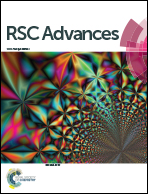Li adsorption on a graphene–fullerene nanobud system: density functional theory approach
Abstract
In this study, we investigated the mechanisms of Li adsorption on a graphene–C60 nanobud system using density functional theory. Li adsorption on the hybrid system was enhanced compared to those using pure graphene and C60. The Li adsorption energies ranged from −1.784 to −2.346 eV for the adsorption of a single Li atom, and from −1.905 to −2.229 eV for the adsorption of two Li atoms. Furthermore, adsorption energies were similar at most positions throughout the structure. The Li adsorption energy of an 18-Li adsorbed system was calculated to be −1.684 eV, which is significantly lower than Li–Li binding energy (−1.030 eV). These results suggest that Li atoms will be adsorbed preferentially (1) between C60 and C60, (2) between graphene and C60, (3) on graphene, or (4) on C60, rather than form Li clusters. As more Li atoms were adsorbed onto the graphene–C60 nanobud system because of its improved Li adsorption capability, the metallic character of the system was enhanced, which was confirmed via analysis of band structure and electronic density of states.


 Please wait while we load your content...
Please wait while we load your content...